As flu season continues, Dr. Megan Gruesser, pediatrician with Community Physician Network, explains that other respiratory illnesses like RSV (Respiratory Syncytial Virus) become common as well. Here’s what parents should know to keep their little ones healthy.
What is RSV?
RSV is a respiratory virus that causes cold-like symptoms in children and adults. However, in children under the age of two and the elderly, it may lead to more severe lower respiratory infections and complications.
RSV causes inflammation and fills the lower airways in the lungs with mucus, making it harder for infants and young children whose lung capacity is smaller to breathe.
How is RSV Spread and What Are the Symptoms?
RSV is usually seasonal, occurring from fall to early spring. It spreads through contact with an infected person by things like coughing, sneezing, a kiss on the forehead or cheek, or by touching contaminated surfaces. Symptoms of RSV usually start four to seven days after exposure and last one to two weeks. Common symptoms include sneezing, a runny or stuffy nose, mild cough, and possibly a fever, often worsening around day three.
For babies and children under two, it can get serious. RSV can lead to infections in the lower lungs, like bronchiolitis or pneumonia. It’s especially tough on young kids because their smaller lungs can’t handle the mucus buildup. It’s important to pay attention to your child’s breathing and seek care when you see any of following:
- Rapid or trouble breathing
- Retractions (Rib muscles sucking in and out with each breath)
- Nasal flaring
- Wheezing or grunting
In severe cases, children may show color changes, which is a symptom of them not getting enough oxygen. If your child’s color changes or you notice blue lips, visit an urgent care location or ER immediately.
Treatment for RSV
The good news? Most cases of RSV can be managed at home with some supportive care such as:
- Nasal suction: Use a nasal suction bulb or aspirator to clear mucus, especially for babies too young to blow their noses.
- Saline drops: Apply nasal saline to loosen thick secretions.
- Humidifier or vaporizer: Add moisture to the air to help ease congestion.
- Elevate the head of the bed: This can help the child breathe more comfortably.
- Fluids: Ensure your child stays hydrated to prevent dehydration.
- Fever relief: Acetaminophen or ibuprofen can help with fever or discomfort.
The American Academy of Pediatrics (AAP) advises against using over-the-counter cough and cold medications for children under six. Be sure to always consult your pediatrician before giving any medications.
Preventing RSV
With RSV being a common winter bug, it can be hard to avoid, but there are some simple things that you can do to protect yourself and your children. To lower the chance of RSV infection:
- Avoid contact with sick individuals.
- Wash hands frequently or use sanitizer to kill germs.
- Minimize secondhand smoke exposure, increasing children’s susceptibility to respiratory infections.
- Ask your doctor about RSV vaccinations available.
Ideal timing to receive Beyfortus, the RSV vaccine, is just before the start of baby’s first RSV season. This can be given during regularly scheduled well-baby visits for your convenience, just be sure to discuss it with your pediatrician ahead of time. Another method of prevention is the mother receiving the vaccine while pregnant to pass on antibodies to their baby, which protects them up to 8 months of age. If you have specific questions about the vaccine, please discuss with your pediatrician or OB/GYN.
These simple actions can help protect your child and reduce the risk of RSV during the winter months.
